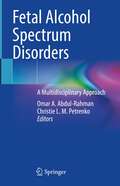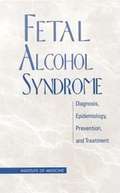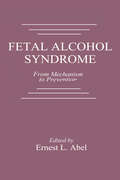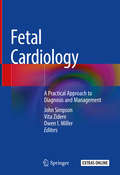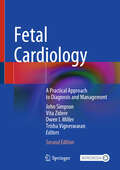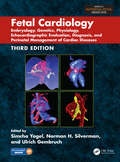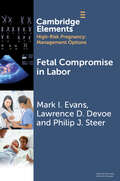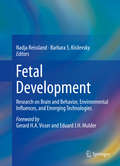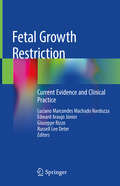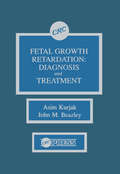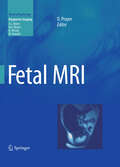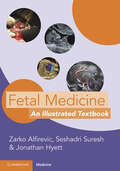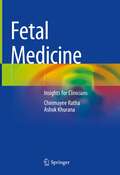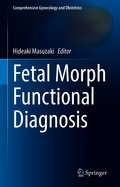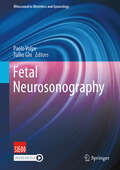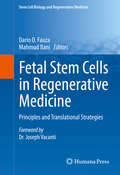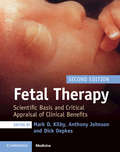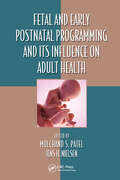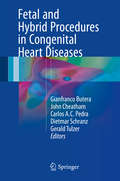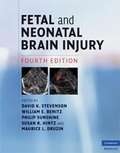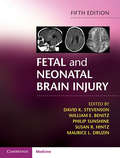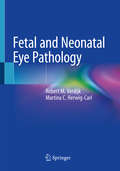- Table View
- List View
Fetal Alcohol Spectrum Disorders: A Multidisciplinary Approach
by Omar A. Abdul-Rahman Christie L. M. PetrenkoFetal alcohol spectrum disorders (FASD) represent a range of physical, mental, and behavioral disabilities caused by alcohol use during pregnancy, or prenatal alcohol exposure (PAE). FASDs are considered to be one of the leading causes of developmental disability, with an estimated 2-5% of children being born with FASD each year in the world. Despite its high prevalence, FASD is often misdiagnosed or underdiagnosed, making intervention more challenging. A multidisciplinary team of providers who understand the diagnostic requirements is crucial for an accurate FASD diagnosis.This text provides a comprehensive, state-of-the art review of this field, and serves as a valuable resource for clinicians and researchers with an interest in FASD. The book provides a detailed overview for clinicians of various backgrounds on the diagnostic process, extensive mechanistic and embryologic data, neuropsychologic aspects of the condition, prevention and treatment approaches, and the ethical, legal, and policy perspectives that impact patients and families.The chapters are organized parallel to the journey of individuals who experience alcohol-related conditions, beginning with the prenatal period addressing epidemiology of alcohol exposure, prevention and interventions, continuing through the fetal experience with a focus on embryology. Challenges of children and their families are considered next including the diagnostic process and health effects. Finally, issues related to systems of care for individuals with FASD and the broader community are addressed. The global context of FASD is presented throughout the textbook.Written by experts in the field, Fetal Alcohol Spectrum Disorders provides a concise yet comprehensive summary of the current status of this issue that helps guide prevention efforts, the diagnostic process, school and community interventions, and global policy efforts.
Fetal Alcohol Syndrome: Diagnosis, Epidemiology, Prevention, and Treatment
by Committee to Study Fetal Alcohol SyndromeIt sounds simple: Women who drink while pregnant may give birth to children with defects, so women should not drink during pregnancy. Yet in the 20 years since it was first described in the medical literature, fetal alcohol syndrome (FAS) has proved to be a stubborn problem, with consequences as serious as those of the more widely publicized "crack babies."This volume discusses FAS and other possibly alcohol-related effects from two broad perspectives: diagnosis and surveillance, and prevention and treatment. In addition, it includes several real-life vignettes of FAS children.The committee examines fundamental concepts for setting diagnostic criteria in general, reviews and updates the diagnostic criteria for FAS and related conditions, and explores current research findings and problems associated with FAS epidemiology and surveillance.In addition, the book describes an integrated multidisciplinary approach to research on the prevention and treatment of FAS. The committee Discusses levels of preventive intervention. Reviews available data about women and alcohol abuse and treatment among pregnant women. Explores the psychological and behavioral consequences of FAS at different ages. Examines the current state of knowledge about medical and therapeutic interventions, education efforts, and family support programs. This volume will be of special interest to physicians, nurses, mental health practitioners, school and public health officials, policymakers, researchers, educators, and anyone else involved in serving families and children, especially in high risk populations.
Fetal Alcohol Syndrome: From Mechanism to Prevention
by Ernest L. AbelRecognition of the relationship between alcohol abuse and adverse prenatal outcomes is reflected in the warning labels on every alcoholic beverage sold in the United States. Because alcohol abuse has serious consequences for both individuals and society as a whole, much research has been devoted to this problem. Fetal Alcohol Syndrome provides straightforward facts regarding the impact of alcohol consumption as it affects the development of the embryo and fetus. Surveying current research of fetal alcohol syndrome and its related problems, the book addresses the immediate effects on development at various stages. Long-term action of prenatal alcohol exposure later in life is also considered. A chapter devoted to assessing the behavior of children who were prenatally exposed to alcohol emphasizes the necessity of longitudinal studies of fetal alcohol syndrome. This important reference offers a thorough overview of a problem that cannot be ignored.
Fetal Cardiology: A Practical Approach To Diagnosis And Management
by John Simpson Vita Zidere Owen I. MillerThis practical book describes a systematic approach to the ultrasound examination of the fetal heart based on accepted screening recommendations. The written content is enhanced by images and videos of both normal and abnormal sonographic findings. Fetal Cardiology: A Practical Approach to Diagnosis and Management goes further than simply describing core screening views. It includes extended views of the fetal heart, the use of Doppler techniques and assessment of fetal cardiac function. “Variants” which can be encountered in practice are described as well as the features of the major groups of cardiac abnormalities and fetal arrhythmias. Because the authors include experienced fetal and paediatric cardiologists, the focus is not only on diagnostic features but also the approach to postnatal care and prognosis. This content is enhanced by inclusion of chapters relating to associated fetal abnormalities, the genetics of congenital heart disease and new imaging modalities such as MRI of the fetal heart. The book equips all those using ultrasound to image the fetus with a clear concise reference to meet the challenge of new guidelines and to expand their knowledge of complementary echocardiographic techniques and management. It details why prenatal recognition of congenital heart disease is being prioritised to allow for parental choice, recognition of associated abnormalities and improvement of postnatal outcome. As such, this book will be important for all professionals, whether they be a cardiologist, fetal medicine specialist, sonographer or midwife.
Fetal Cardiology: A Practical Approach to Diagnosis and Management
by John Simpson Vita Zidere Owen I. Miller Trisha VigneswaranThis thoroughly updated practical book describes a systematic approach to ultrasound examination of the fetal heart based on accepted screening recommendations. The content is enhanced by images and videos of both normal and abnormal sonographic findings that brings the topic to life and provides the reader with critical clinical information on best practice. Fetal Cardiology: A Practical Approach to Diagnosis and Management goes further than simply describing core screening views. It includes extended views of the fetal heart, the use of Doppler techniques and assessment of fetal cardiac function. “Variants” that can be encountered in practice are described as well as the features of the major groups of cardiac abnormalities and fetal arrhythmias. Because the authors include experienced fetal and paediatric cardiologists, the focus is not only on diagnostic features but also the approach to postnatal care and prognosis. This content is enhanced by inclusion of chapters relating to associated fetal abnormalities, the genetics of congenital heart disease and new imaging modalities such as MRI of the fetal heart. This book equips those using ultrasound to image the fetus with a clear concise reference to meet the challenge of new guidelines and to expand their knowledge of complementary echocardiographic techniques and management. It details why prenatal recognition of congenital heart disease is being prioritised to allow for parental choice, recognition of associated abnormalities and improvement of postnatal outcome. As such, this book is a vital resource for all professionals, whether they be a cardiologist, fetal medicine specialist, sonographer or midwife.
Fetal Cardiology: Embryology, Genetics, Physiology, Echocardiographic Evaluation, Diagnosis, and Perinatal Management of Cardiac Diseases, Third Edition
by Simcha Yagel, Norman H. Silverman and Ulrich GembruchThe third edition of this established reference is the product of the combined efforts of many professionals – obstetricians, pediatric cardiologists, sonographers, molecular biologists, and medical physicists – and is a comprehensive guide intended for anyone interested in scanning the fetal cardiac system.
Fetal Compromise in Labor (Elements in High Risk Pregnancy: Management Options)
by Philip J. Steer Mark I. Evans Lawrence D. DevoeSixty years ago, the purpose of introducing electronic fetal heart rate monitoring (EFM) was to reduce the incidence of intrapartum stillbirth. However, by the early 1980s, with falling stillbirth rates, fetal blood sampling had been widely abandoned, as many considered that EFM was sufficient on its own. Unfortunately, while the sensitivity of EFM for the detection of potential fetal compromise is high, specificity is low, and there is a high false positive rate which has been associated with a rising cesarean section rate. The authors suggest that EFM is considered and analyzed as a classic screening test and not a diagnostic test. Furthermore, it requires contextualization with other risk factors to achieve improved performance. A new proposed metric, the Fetal Reserve Index, takes into account additional risk factors and has demonstrated significantly improved performance metrics. It is going through the phases of further development, evaluation, and wider clinical implementation.
Fetal Development
by Nadja Reissland Barbara S. KisilevskyThis book provides an overview of fetal psychobiological research, focusing on brain and behavior, genetic and epigenetic factors affecting both short and long-term development, and technological breakthroughs in the field. These focal points intersect throughout the chapters, as in the challenges of evaluating the fetal central nervous system, the myriad impacts of maternal stressors and resiliencies, and the salience of animal studies. It also discusses specific monitoring and assessment methods, including cardiotocography, biomagnetometry, 4D ultrasound, in utero MRI, and the KANET test. Spanning assessment, identification, and pre- and postnatal intervention, the book weighs the merits of standardized evaluations and argues for more integrative research in the future. Included in the coverage: Effects on the fetus of maternal anxiety, depression, and stress during pregnancy. Clinical and experimental research in human fetuses and animal models. Observational research including the use of behaviors in developing tests to assess fetal health. Fetal auditory processing and implications for language development. Fetal effects of prenatal exposure to selective SRI antidepressant exposure. Structural and functional imaging of the prenatal brain. The effects of alcohol exposure on fetal development. Fetal Development: Research on Brain and Behavior, Environmental Influences, and Emerging Technologies is an essential resource for researchers, clinicians and related professionals, as well as students in a wide range of fields such as developmental psychology, pediatric and obstetrical medicine, neuroscience, nursing, social work, and early childhood education.
Fetal Growth Restriction: Current Evidence And Clinical Practice
by Giuseppe Rizzo Edward Araujo Júnior Russell Lee Deter Luciano Marcondes NardozzaFetal growth restriction (FGR) is a condition that affects 5%–10% of all pregnancies and is the second most common cause of perinatal mortality. Fetuses with FGR present with a greater risk of long-term health defects as impaired neurological and cognitive development and cardiovascular or endocrine diseases in adulthood. Due to its high prevalence and serious long term consequences, an in-depth understating of the diagnosis and management of FGR is essential for all those professionals involved in prenatal care, since it can prevent unwanted outcomes both to the mother and to the newborn. On the last years, the knowledge about fetal growth restriction has evolved considerably, with an increasing number of articles being published on this topic and new concepts being described, including new diagnostic guidelines. Even so, there are no recent books fully dedicated to FGR; this theme has only generally been discussed in chapters in larger obstetrics and neonatology books. This current book intends to present and discuss the state of the art on FGR in a clear and didactical way. It will focus on the main topics related to FGR, including its etiology, classification, prediction, diagnosis, and management, as well as on its neurological complications and maternal cardiovascular involvement. Written by experienced and renowned gynecologists from Brazil, Italy and the US, this book will be a comprehensive guide, directed to all gynecologists, radiologists and general practitioners who are involved in prenatal care, as well as to interns, residents, professors and researchers in the field.
Fetal Growth Retardation: Diagnosis and Treatment
by Asim Kurjak J.M. BeazleyIn this unique book emphasis is placed on tests necessary to evaluate fetal well-being and to detect those fetuses at risk of hypoxia and acidosis in utero. Written by pioneers in the neonatal field, this publication contains chapters on the pathophysiology , obstetric management, and collagen diseases of intrauterine growth retardation. Ultrasound in detection of growth retarded fetuses is explored, as well as magnetic resonance imaging and magnesium substitution for the prevention of intrauterine growth retardation. Containing never-before-published information, this volume is an excellent reference source for both investigators in the field and those entering it.Topics Include:Perinatal growth chart for international referenceUltrasound guided procedures in small for gestation fetusesUtero-placental and fetal circulation
Fetal MRI
by Daniela Prayer Albert L. BaertThis is the most comprehensive book written on the subject of fetal MRI. It provides a practical hands-on approach to the use of state-of-the-art MRI techniques and the optimization of sequences. The book also contains numerous high-quality illustrations.
Fetal Medicine (Royal College of Obstetricians and Gynaecologists Advanced Skills)
by Bidyut Kumar Zarko AlfirevicBased on the curriculum of the Royal College of Obstetricians and Gynaecologists' Advanced Training Skills Module in Fetal Medicine, this book provides a comprehensive knowledge base for all doctors practising in obstetrics and maternal-fetal medicine worldwide. It acts as a reference source for the many changing concepts in fetal medicine and is well-illustrated with images of normal and abnormal findings in pregnancy that will facilitate proper understanding of normal and pathological fetal development. Coverage includes embryology, fetal physiology; fetal anomalies; fetal diseases; prescribing and teratogenesis in pregnancy; termination of pregnancy; fetal growth and wellbeing; multiple pregnancy; the placenta and amniotic fluid; and diagnostic and therapeutic invasive procedures. Readers will benefit from the theoretical knowledge and vast clinical experience of the internationally renowned authorship. Overall this book will prepare you for dealing with congenital abnormalities detected during pregnancy, including the organization and supervision of screening programmes for structural and chromosomal anomalies. Covers the curriculum for the RCOG's Advanced Training Skills Module (ATSM) in fetal medicine Also of interest to all trainees and consultants looking to develop and update their skills in fetal medicine Chapter authors are all recognized experts in their fields
Fetal Medicine for the MRCOG and Beyond
by Alan Cameron Janet Brennand Lena Crichton Janice GibsonA solid understanding of fetal medicine is essential for the practice of obstetrics and gynaecology. This comprehensive book, which has been extensively updated to reflect current clinical practice and developments in the field since publication of the original edition, provides a thorough overview of fetal medicine, covering: screening for chromosomal abnormalities; prenatal diagnostic techniques; the routine anomaly scan; fetal structural abnormalities; fetal therapy; prenatal diagnosis and management of non-immune hydrops fetalis; termination of pregnancy for fetal abnormality; fetal growth restriction; twin pregnancy; and fetal infection. The book is primarily designed to provide a comprehensive summary for candidates preparing for the Part 2 MRCOG examination, and as such covers the RCOG curriculum for fetal medicine. It is also a valuable guide for all healthcare professionals working in the field, including trainees, consultants and midwives.
Fetal Medicine: An Illustrated Textbook
by Zarko Alfirevic Seshadri Suresh Jonathan HyettEvidence-based clinical guidelines are designed to provide systematically developed recommendations to assist clinicians and their patients in making decisions about appropriate treatment for specific conditions. While these may often be widely available, nowhere are they collated into a single, practical text. This book will fill this need for those working in maternal-fetal medicine, comprehensively covering the conditions, diagnostic and therapeutic challenges faced by those working in fetal care. Presented in highly illustrated, algorithm format with fetograms and autopsy correlations included, this book will aid in the diagnosis, investigation, counselling and therapeutic options for the management of fetal abnormalities and disorders.
Fetal Medicine: Insights for Clinicians
by Chinmayee Ratha Ashok KhuranaThis book provides an overview of Fetal Medicine practice focusing on various aspects of fetal health such as screening for fetal aneuploidies and imaging for fetal anomalies, their basic management and technological breakthroughs.Although the field of Fetal Medicine is very wide, this book has condensed the important issues and is written in an " easy to read" format to simplify concepts for the readers. Fetal Medicine has emerged as a separate specialization and has an interdisciplinary appeal for clinicians. With the advent of knowledge and awareness in this field there are emerging challenges in counseling patients regarding available options. This book aims to be a ready reference for clinicians in Obstetrics and Radiology who encounter patients with fetal anomalies, growth disorders, multiple pregnancies and genetic /chromosomal problems. This is a highly informative and carefully presented book providing insights for clinicians with an interest in Fetal Medicine
Fetal Morph Functional Diagnosis (Comprehensive Gynecology and Obstetrics)
by Hideaki MasuzakiThis book explores the recent clinical and research findings in the field of prenatal screening and diagnosis. It presents new devices and tests such as real-time 3D ultrasound, ultrafast fetal MRI, and next-generation sequencing and discusses genetic counseling and fetal therapy. Written by pioneering scientists, the book is divided into six themed parts: ultrasound examination, genetic tests, genetic disorders, chromosomal diseases, genetic counseling, and techniques, presenting carefully prepared original data.This thought-provoking, instructive and informative book is intended for geneticists, obstetricians, pediatricians, genetic counselors and nurses. Although the incidence of congenital abnormalities such as structural, chromosomal and genetic disorders is very low, it is important to have accurate information on their incidence and likely outcome, and on the screening and diagnosis of congenital abnormalities during pregnancy care. This book provides valuable insights into prenatal screening, genetic counseling and fetal diagnosis.
Fetal Neurosonography (Ultrasound in Obstetrics and Gynecology)
by Paolo Volpe Tullio GhiWhat would make this book unique is its focus on the fetal central nervous system (CNS) ultrasound, encompassing the wide range of CNS anomalies and the need for in-depth knowledge in fetal brain and spine normal anatomy and related abnormalities. From the anatomy and pathophysiology of the main CNS anomalies to the latest advancements in diagnostic techniques and therapeutic interventions, this book provides a thorough exploration of the subject matter.One of the key strengths of this book series lies in its structured approach. Each volume follows an organized framework, enabling readers to navigate through the content effortlessly. From the fundamentals of CNS ultrasound imaging to the intricacies of differential diagnosis, counseling and management of CNS anomalies, this book presents information in a logical and accessible manner. This structure not only facilitates comprehension but also allows readers to quickly locate specific topics and delve deeper into areas of interest.By creating this book, our aim is to fill a critical gap in the field of fetal medicine and ultrasound education. While numerous resources exist, this book stands out due to its comprehensive nature, covering both the theoretical foundations and practical applications of neurosonography. It also offers essential information for counseling and presents high-quality ultrasound images, enabling specialists to systematically and confidently approach normal CNS anatomy and accurately diagnose and manage CNS abnormalities, also exploring the role of additional imaging techniques, such as MRI, and genetic testing. This book bridges the divide between research and clinical practice, equipping healthcare professionals with the necessary knowledge and skills to provide optimal care for women throughout their reproductive lifespan. In conclusion, this book offers a resource for healthcare professionals, researchers, educators, and students in the field, bridging the gap between theory and practice and aiming to elevate the standard of care in fetal neurosonography.
Fetal Stem Cells in Regenerative Medicine
by Dario O. Fauza Mahmud BaniThis book explores the regenerative properties of fetal stem cells, from feto-maternal cell traffic through perinatal stem cells, with a discussion of key topics including stem cell banking, drug screening, in utero stem cell transplantation and ethical considerations. The expertly authored chapters also delve into embryonic, amniotic membrane, and umbilical cord blood stem cells; fetal development models; fetal cell reprogramming; culture methods; disease models; perinatal gene therapy, and more. These chapters are grouped into four sections, each discussing a separate prenatal stem cell population and providing fascinating historical contexts for our knowledge of these systems. Featuring a foreword written by the renowned Dr. Joseph Vacanti of the Harvard Stem Cell Institute, Fetal Stem Cells in Regenerative Medicine: Principles and Translational Strategies is a welcome and timely contribution to the Stem Cell Biology and Regenerative Medicine series. It is essential reading for scientists and researchers, clinicians and residents, and advanced students involved in stem cells, regenerative medicine, tissue engineering, and related disciplines such as embryology.
Fetal Therapy:
by Mark D. Kilby Dick Oepkes Anthony JohnsonFetal treatment, particularly complex fetal therapy, is an emergent and expanding field. This comprehensive text focuses on areas of fetal disease and pathophysiology that can be treated in utero and the benefits and problems with such therapy. Both medical (non-invasive) and surgical procedures are discussed, drawing on the expertise of an internationally renowned author team. Each chapter includes a comprehensive overview of the basic science underlying fetal pathology, as well as discussing the highest level of technical performance of fetal interventions. Contributions from fetal therapy 'centers-of-excellence' around the world collectively emphasize the need for an evidence-based approach to the field. This volume is useful both as a quick reference guide to the latest fetal therapy options and as an in-depth study book for maternal-fetal medicine and neonatology specialists at any stage of their career who are seeking to acquire essential background knowledge. Indispensable on any bookshelf in fetal medicine units.
Fetal Therapy: Scientific Basis and Critical Appraisal of Clinical Benefits
by Mark D. Kilby Dick Oepkes Anthony JohnsonUpdated by a team of internationally renowned experts, this book gives a thorough overview of fetal pathophysiology and an evidence base for in utero: both medical (non-invasive) and surgical treatments. Many topics are expanded to cover recent advances, including: stem cell transplantation; tissue scaffolding; minimally invasive approaches to 'open fetal surgery'; the etiology, prevention and treatment of preterm birth and PROM; the genetic etiologies of fetal disease; and gene therapy. In addition, there are in-depth discussions as to the role of open fetal myelomeningocele repair and several fetoscopic approaches to therapy. The international editors have added important new chapters on reducing stillbirth and prenatal counselling. This book is an invaluable reference guide to the latest fetal therapy options, and an essential, in-depth study book for maternal-fetal and neonatology specialists.
Fetal and Early Postnatal Programming and its Influence on Adult Health (Oxidative Stress and Disease)
by Mulchand S. Patel Jens H. NielsenThere is a documented link between fetal nutrition and the development of disease risk in adult life. Including the early postnatal period, during which a newborn continues to grow rapidly influenced by environmental factors, suggests that individuals are subject to risks for more than just the fetal period. Fetal and Early Postnatal Programming and its Influence on Adult Health focuses on interrelated aspects of cellular programming related to early nutrition and this potential global health problem.
Fetal and Hybrid Procedures in Congenital Heart Diseases
by Dietmar Schranz Gianfranco Butera John Cheatham Carlos A. C. Pedra Gerald TulzerThis book is an ideal, up-to-date guide to the application of fetal interventions and hybrid procedures, in which the surgeon and the interventional cardiologist work together, for the treatment of congenital heart diseases at a very early stage when disease outcome may be altered. State of the art data and clear instruction are offered on techniques such as fetal pulmonary and aortic valve dilatation, fetal interatrial septum stenting, hybrid defect closure, hybrid stent implantation, and hypoplastic left heart syndrome therapy. Recognized experts describe the benefits of such early interventions, particularly evident in the case of valve disease, and explain how the hybrid strategy, by combining advantages and tools from each approach, can reduce invasiveness and risks and improve results. The book also looks ahead to the likely impact of new technologies, including nanotechnology, that will soon be available. Fetal and Hybrid Procedures in Congenital Heart Diseases will be a rich source of knowledge, step-by-step guidance, and practical tips and tricks for obstetricians/gynecologists, fetal cardiologists, pediatric cardiologists, interventional cardiologists, congenital cardiac surgeons, anesthesiologists, and intensivists.
Fetal and Neonatal Brain Injury
by David K. Stevenson William E. Benitz Philip Sunshine Susan R. Hintz Maurice L. DruzinImprovements in the detection of fetal and neonatal brain injuries, advances in our understanding of the pathophysiology, cellular and molecular bases of encephalopathy, and new treatment options have all combined to produce significant changes in the management of neonatal brain disorders in the past few years. This new edition of Fetal and Neonatal Brain Injury brings the reader fully up to date with all advances in clinical management and outcome assessment. New material includes pregnancy-induced hypertension, HELLP syndrome and chronic hypertension, complications of multiple gestation, neurogenic disorders of the brain, neonatal stroke and much more. An expanded, highly illustrated chapter on structural and functional imaging of the fetal and neonatal brain is also included. An outstanding international team of highly experienced neonatologists and maternal-fetal medicine clinicians have produced a practical, authoritative clinical text that gives clear management advice to all clinicians involved in the treatment of these patients.
Fetal and Neonatal Brain Injury: Mechanisms, Management And The Risks Of Practice
by David K. Stevenson William E. Benitz Philip Sunshine Susan R. Hintz Maurice L. DruzinImprovements in the detection of fetal and neonatal brain injuries, advances in our understanding of the pathophysiology, cellular and molecular bases of encephalopathy, and new treatment options have all combined to produce significant changes in the management of neonatal brain disorders in the past few years. This new edition of Fetal and Neonatal Brain Injury brings the reader fully up to date with all advances in clinical management and outcome assessment. New material includes pregnancy-induced hypertension, HELLP syndrome and chronic hypertension, complications of multiple gestation, neurogenic disorders of the brain, neonatal stroke and much more. An expanded, highly illustrated chapter on structural and functional imaging of the fetal and neonatal brain is also included. An outstanding international team of highly experienced neonatologists and maternal-fetal medicine clinicians have produced a practical, authoritative clinical text that gives clear management advice to all clinicians involved in the treatment of these patients.
Fetal and Neonatal Eye Pathology: An Atlas
by Robert M. Verdijk Martina C. Herwig-CarlThis richly illustrated book discusses the fetal eye, offering a brief introduction to the topic and discussing its development and treatment. The high-quality reference images allow the morphological fetal age to be determined, and the authors provide examples of artifacts and real-world findings to simplify histopathological diagnosis. The book also discusses findings in fetal eyes, presenting typical examples of common malformations, including clinical and histological pictures as well as additional findings from other specialties (such as neuropathology, genetics). In addition, it covers non-specific ocular malformations. It particularly addresses documentation and interpretation of cases of suspected Shaken-Baby Syndrome, which is of forensic importance. In the context of retinopathy of prematurity, histopathological and clinical findings are correlated. The book provides reference images of fetal development and guidelines on grossing and handling fetal eyes, and also explores the complicated topic of artifacts, including case illustrations with comprehensive information concerning other specialties. Lastly it discusses clinically and forensically relevant findings in newborns. It guides ophthalmic and pediatric pathologists in the interpretation of ocular findings, helping to narrow down differential diagnoses in fetal pathology, while at the same time serving as a valuable tool for specialists who do not have a great deal of experience in the examination of fetal eyes.
